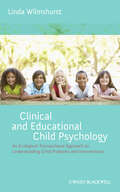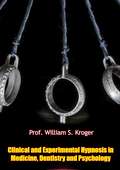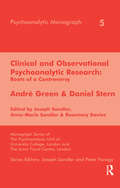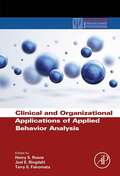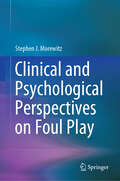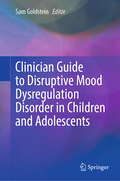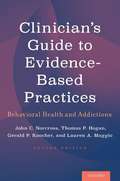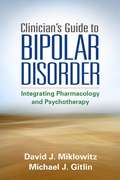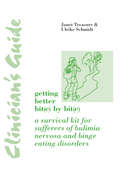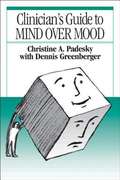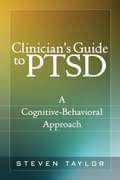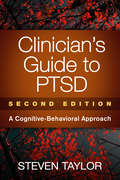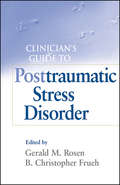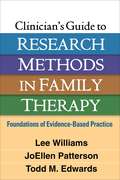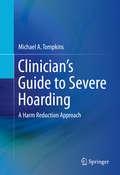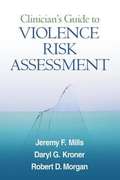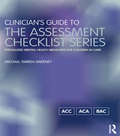- Table View
- List View
Clinical and Educational Child Psychology
by Linda WilmshurstClinical and Educational Child Psychology: An Ecological-Transactional Approach to Developmental Problems and Interventions explores developmental milestones in early childhood and adolescence and provides intervention strategies in both clinical and educational contexts. Currently one of the only books on child psychopathology that is up to date with recently-released DSM-V standards Explores how challenges commonly encountered at ages 3-18 can influence development Draws on contemporary research on the developing brain to show why some children may be vulnerable to a host of clinical and educational problems Equips readers to develop case formulations and interventions in a holistic way Discusses developmental milestones and adjustment disorders in both early childhood and adolescence
Clinical and Educational Interventions with Fathers
by Alan Hawkins Jay FaganCall on men's hidden strengths to help them become responsible fathers in even the most challenging circumstances!Clinical and Educational Interventions with Fathers gives you fresh approaches for effective interventions with fathers. Whether by calling on their faith to help them deal with the complexities of fatherhood or offering high-tech interventions on the Internet, these techniques help men find their strengths, maintain their masculinity, and learn to guide, nurture, and discipline with love and responsibility. Instead of thinking of fathers as deficient, the book emphasizes finding fathers’strengths and potentials for growth. It also respects the diversity of parenting styles among fathers from various ethnic, racial, and class backgrounds.No man wants to be a bad father. Nevertheless, many men in our culture do not know how to care for the children they beget. Trapped by stereotypes of masculine behavior and deprived of positive role models, they find themselves trying to do the challenging work of fatherhood without the necessary resources, information, or support.Clinical and Educational Interventions with Fathers offers positive approaches to helping men become responsible fathers, including: designing special techniques and programs to help fathers in prison and other challenging circumstances helping fathers manage anger developing therapeutic support groups for African-American men offering Web-based support for fathers training staff to recognize and respond to fathers’unique needs finding legal tools to support fathers’rightsReaching fathers has become an ever more urgent priority for practitioners as family structure and family life change. Traditional social-service programs for mothers tend not to work well with men's very different needs and attitudes. Yet very little has been published on successful interventions with fathers. Clinical and Educational Interventions with Fathers fills that gap and suggests promising new directions for further research in this field. By offering positive, tested ways to help men become responsible fathers, this volume will help you improve their lives and the lives of their sons and daughters.
Clinical and Experimental Hypnosis in Medicine, Dentistry and Psychology
by Prof. William S. KrogerOriginally published in 1963, this definitive textbook, written by pioneering Professor William S. Kroger's, defined and shaped the field of hypnosis for over 20 years after its publication, and remains an authoritative text in its field to this day.Together with his seminars presented in association with the American Society of Clinical Hypnosis, Professor Kroger's textbook changed the perception of hypnosis from being a novelty to a legitimate and respected medical option, and solidified his reputation as a leader in the field.
Clinical and Neuropsychological Aspects of Closed Head Injury (Brain, Behaviour and Cognition)
by Dr J RichardsonIn all industrialised countries, closed head injuries are responsible for vast numbers of hospital admissions and days of work lost. For instance, about 120,000 patients are admitted to hospital in the United Kingdom each year with a diagnosis that reflects closed head injury. Such injuries are a major cause of deaths following accidents, especially those that involve children and young people, and they are also a major cause of handicap and morbidity among the survivors. This clinical condition is intrinsically a neurological one, but its proper evaluation demands an understanding of the associated psychology and psychopathology. At the same time, a major neurological condition with such a high level of incidence ought to be extremely informative about the functioning of the human brain and hence provide a major focus for neuropsychological investigation. In this book, the author seeks to integrate these two different perspectives by reviewing the clinical and neuropsychological aspects of closed head injury in a manner that is equally intelligible to researchers interested in the effects of brain damage upon human behaviour and to practitioners who are responsible for the assessment, management and rehabilitation of head-injured patients.This is the second edition of a book which was first published in 1990, and which has been extensively revised in the light of the subsequent research in the field. The book begins by considering the epidemiology, causes and structural neuropathology of closed head injury. It then considers the impact of closed head injury on memory, cognition, language, communication, personality and social behaviour. Finally it outlines the outcome, the mechanisms of recovery and the prospects for rehabilitation.
Clinical and Observational Psychoanalytic Research: Roots of a Controversy - Andre Green & Daniel Stern (The\psychoanalytic Monograph Ser. #Vol. 5)
by Rosemary DaviesFew topics elicit greater controversy within psychoanalysis today than the role of research in justifying or expanding upon analytic theory. The text collects papers from a London conference, along with additional material, to explore the work of discussants Daniel Stern and Andre Green. Stern, whose work and psychoanalysis and infant observation is world-renowned, and Green, the French psychoanalyst whose trenchant views on the limitations of research are equally well known, each focus on the issue of infant research and its long history within the psychoanalytic movement.Additional discussions by three prominent British psychoanalysts, Anne Alvarez, Irma Brenman Pick, and Rozine Jozef Perelberg, expose a different point of view from that of green and Stern. Also included is a previous debate on this topic between Andre Green and Robert S. Wallerstein, former president of the International Psychoanalytic Association. An illuminating introductory chapter by Riccardo Steiner further describes the main points of the debate with marvelous clarity. This book will be invaluable for all those who wish to involve themselves with contemporary views on this important topic.
Clinical and Organizational Applications of Applied Behavior Analysis (Practical Resources for the Mental Health Professionals Series)
by Henry S. Roane Terry S. Falcomata Joel E. RingdahlApplied behavior analysts use applied research to create and implement effective evidence-based procedures in schools, homes, and the community, which have proved effective in addressing behaviors associated with autism and other developmental disorders. The principles underlying this therapeutic approach have been increasingly effective when applied to other populations, settings, and behaviors. <P><P>Clinical and Organizational Applications of Applied Behavior Analysis explores data-based decision-making in depth to inform treatment selection for behavior change across various populations and contexts. Each chapter addresses considerations related to data collection, single-case research design methodology, objective decision-making, and visual inspection of data. The authors reference a range of published research methods in the area of applied behavior analysis (ABA) as it has been applied to specific topics, as well as utilizing their own clinical work by providing numerous case examples.
Clinical and Psychological Perspectives on Foul Play
by Stephen J. MorewitzClinical and Psychological Perspectives on Foul Play examines a wide range of factors that can influence how police determine foul play in possible homicide cases and in other possible crimes. It develops a new theory of uncertainty at micro, meso, and macro levels to explain how law professionals arrive at this decision. Specifically, it examines the extent to which uncertainty in these situations can be influenced by media coverage, family and community pressures, socioeconomic factors, demographic elements of victims, as well as police knowledge and resources. Written for forensic practitioners, this book describes how these professionals can consult with law enforcement on such issues as the staging of crime scenes to mask intent, the initiation of community strategies to find missing persons, and the reliability of behavioral profiles. The latest research from the Foul Play Project and the Missing Persons Project are employed to support the recommendations in this book and to point the way toward further research in this area.
Clinical and Research Uses of an Adolescent Mental Health Intake Questionnaire: What Kids Need to Talk About
by Irwin Epstein Ken Peake Daniel MedeirosLearn how to better clinically serve "risky" adolescents-from the clients themselves!Clinical and Research Uses of an Adolescent Mental Health Intake Questionnaire: What Kids Need to Talk About explores the research on adolescent behavior culled from the answers to a clinician-designed intake questionnaire given to adolescent clients asking how they view their own risks, what they worry about, and what they wish to talk about. Respected authorities discuss the enlightening findings and present ways to reshape services, taking into account customer preference, risk and worry, and youth development (YD) perspectives while presenting practical clinical strategies to engage at-risk adolescents in mental health treatment.Clinical and Research Uses of an Adolescent Mental Health Intake Questionnaire: What Kids Need to Talk About provides conceptual models that practitioners and organizations can use to develop reflective practices and to understand better how to engage adolescent clients in treatment. The book includes three case studies that illustrate an organization&’s experience in developing ways for organizational learning, including the clinicians&’ own accounts of their experience in conducting practice-based research. Two chapters describe the development and the clinical uses of the intake questionnaire and offer guidelines for other practitioners to develop their own. The book discusses specific findings about adolescent risk, worries, and desire to talk across a wide range of psychosocial domains such as education and work, sex and sexuality, safety, substance abuse, and family and friends. Other research examines adolescent risk and vulnerability profiles of lesbians, gays, and bisexuals, as well as the impact of racism. Finally, the book builds upon this empirical analysis to address the clinical challenge of engaging "risky" adolescents in counseling.Clinical and Research Uses of an Adolescent Mental Health Intake Questionnaire: What Kids Need to Talk About analyzes: adolescent risks, worries, and coping adolescent help seeking and desire to talk in counseling youth development (YD) and adolescent vulnerability urban adolescents&’ health and mental health concerns effectively engaging adolescents in counseling collaborative strategies for clinicians and managers reflectivity and learning in human service organizationsClinical and Research Uses of an Adolescent Mental Health Intake Questionnaire: What Kids Need to Talk About presents essential information for social workers, mental health professionals who work with adolescents, adolescent researchers, pediatricians and adolescent medicine practitioners, teachers, students, and youth workers.
Clinical and Theoretical Aspects of Perversion: The Illlusory Bond (The International Psychoanalytical Association Controversies in Psychoanalysis Series)
by Juan Pablo Jimenez'Perversion is a challenge for theory and psychoanalytic practice that Juan Pablo Jimenez and Rodolfo Moguillansky, American psychoanalysts known for the originality of their contributions, have managed successfully. In this book they offer us vivid and detailed clinical material of patients of analysis who presented various kinds of perversions, which they accompany by a comprehensive and accurate review of major psychoanalytic contributions on the subject, and their own contributions to it.' The reader will find not only scholarship, but also he will find himself trapped in a thriller where the analyst is continually asked to leave his role as analyst to enter a game that fascinates and rejects. In a masterful way the authors describe their own internal vicissitudes in the treatment of these patients, the counter-transferential difficulties and how perversion becomes a source of inevitable collusions in the mind of the analyst.
Clinician Guide to Disruptive Mood Dysregulation Disorder in Children and Adolescents
by Sam GoldsteinThis book examines disruptive mood dysregulation disorder (DMDD) during childhood and adolescence. It explores the ways in which explosive anger outbursts and persistent irritability are among the most problematic symptoms in child and adolescent mental health. and may present as a feature of many different psychiatric illnesses. The volume addresses the myriad challenges that youth with a focus on the DMDD diagnosis experience. Chapters focus on key issues of development, behavior, achievement, social relations, and mood. The book describes how to diagnose and conduct clinical assessments of child and adolescent personality and behavior with suspected DMDD. Key areas of coverage include: Comprehensive history of mood dysregulation research and current trends in psychiatric classification (e.g., DSM-5, Research Domain Criteria) and their influence on the clinical assessment of children and adolescents with suspected DMDD. Updates of professional standards to guide clinicians and diagnosticians and discussions of practical considerations in planning and conducting clinical assessments for children with DMDD. Reviews the most recent editions of questionnaires and tests used in the clinical assessment of child and adolescents with suspected DMDD. Differential diagnosis and practical methods for integrating assessment information to develop an effective, multidisciplinary treatment plan. Review of current trends in psychiatric and psychological treatment of DMDD. Clinician Guide to Disruptive Mood Dysregulation Disorder in Children and Adolescents serves as an essential resource for researchers, professors, and graduate students as well as veteran and early-career clinicians and professionals across such interrelated disciplines as school, clinical child, developmental, and educational psychology, child and adolescent psychiatry, school counseling, social work, and public health.
Clinician's Guide To Evidence-based Practices: Behavioral Health And Addictions
by John C. Norcross Gerald P. Koocher Thomas P. Hogan Lauren A. MaggioClinician's Guide To Neuropsychological Assessment
by Rodney D. VanderploegNeuropsychological assessment is a difficult and complicated process. Often, experienced clinicians as well as trainees and students gloss over fundamental problems or fail to consider potential sources of error. Since formal test data on the surface appear unambiguous and objective, they may fall into the habit of overemphasizing tests and their scores and underemphasizing all the factors that affect the validity, reliability, and interpretability of test data. But interpretation is far from straightforward, and a pragmatic application of assessment results requires attention to a multitude of issues. This long-awaited, updated, and greatly expanded second edition of the Clinician's Guide to Neuropsychological Assessment, like the first, focuses on the clinical practice of neuropsychology. Orienting readers to the entire multitude of issues, it guides them step by step through evaluation and helps them avoid common misconceptions, mistakes, and methodological pitfalls. It is divided into three sections: fundamental elements of the assessment process; special issues, settings, and populations; and new approaches and methodologies. The authors, all of whom are actively engaged in the clinical practice of neuropsychological assessment, as well as in teaching and research, do an outstanding job of integrating the academic and the practical. The Clinician's Guide to Neuropsychological Assessment, Second Edition will be welcomed as a text for graduate courses but also as an invaluable hands-on handbook for interns, postdoctoral fellows, and experienced neuropsychologists alike. No other book offers its combination of breadth across batteries and approaches, depth, and practicality.
Clinician's Guide to Bipolar Disorder
by Michael J. Gitlin David J. MiklowitzThis much-needed volume gives clinicians essential strategies for managing the complexities of bipolar disorder and tailoring treatment to each patient's changing needs. Highly readable, accessible, and pragmatic, the book provides expert guidance on critically important treatment questions. It addresses which medications to try and at what dosages, what psychosocial interventions are most helpful at different phases of the illness, how to continually monitor and fine-tune treatment to keep patients functioning well, and how to involve family members productively. The authors draw on state-of-the-art research as well as extensive clinical experience as a psychotherapist and a psychopharmacologist. Vivid case material is included throughout. Reproducible questionnaires and forms can be downloaded and printed in a convenient 8 1/2" x 11" size.
Clinician's Guide to Getting Better Bit(e) by Bit(e): A Survival Kit for Sufferers of Bulimia Nervosa and Binge Eating Disorders
by Janet Treasure Ulrike SchmidtThe publication four years ago of Getting Better Bit(e) by Bit(e), written by two eating disorder specialists at London's world-famous Maudsley Hospital, was a milestone in the treatment of bulimia. For the first time a self-help book was shown, by rigorous clinical trials, to cure a significant fraction of women suffering from bulimia, and to reduce the therapist contact time needed by others. Getting Better Bit(e) by Bit(e) offered an efficient way of treating bulimic patients, which would be valued by any resource-conscious health service. The authors of Getting Better Bit(e) by Bit(e) have now written this Clinician's Guide, to help health care professionals maximize the benefit that patients obtain from the self-help book. Based on the authors' wide-ranging experience of treating eating disorder patients, it provides a step-by-step account of how the chapters in Getting Better Bit(e) by Bit(e) can be used to ameliorate various aspects of bulimics' difficulties, with examples drawn from real patients' case histories. Particular emphasis is given to the problem of motivating patients who are reluctant to change their behaviour, using Miller and Rollnick's motivational interviewing approach. The Clinician's Guide to Getting Better Bit(e) by Bit(e) will be invaluable for all those treating sufferers of bulimia.
Clinician's Guide to Mind Over Mood
by Christine A. Padesky Christine GreenbergerIf you'd like to assign MIND OVER MOOD to your clients, but aren't sure about how to incorporate it into practice, you'll find the answers you need in CLINICIAN'S GUIDE TO MIND OVER MOOD. This essential companion guide will show you how to introduce MIND OVER MOOD to your clients, integrate it with your in-session therapy work, increase client compliance in completing home assignments, and overcome common difficulties that may arise. The authors clearly demonstrate how to use MIND OVER MOOD with individuals, couples, and groups, both in session and at home. Brief therapy and inpatient settings are also discussed in detail. Step-by-step instructions are provided on how to tailor the program to follow cognitive therapy treatment protocols for a range of diagnoses, including depression, anxiety, personality disorders, panic disorder, substance abuse, and complex, multiple problems. Also outlined are ways to use MIND OVER MOOD to pinpoint the development of specific cognitive, affective, and behavioral skills. The volume is richly illustrated with case examples and sample client-therapist dialogues in every chapter. Guidance is offered on how to review home exercises and worksheets in session and how to perform effective guided discovery. The authors also provide a detailed chapter on setting therapy goals. Creative ways for engaging clients who have negative reactions to a manual are described, as are strategies for maintaining collaboration with clients with personality disorders. Each chapter concludes with a "troubleshooting guide," which therapists can use to navigate impasses, and the book itself concludes with an informative chapter on therapist training and MIND OVER MOOD.
Clinician's Guide to PTSD
by Steven Taylor Barbara RothbaumGrounded in the latest clinical and neurobiological research, this book provides both an understanding of posttraumatic stress disorder (PTSD) and a guide to empirically supported treatment. The author offers well-documented, practical recommendations for planning and implementing cognitive-behavioral therapy with people who have experienced different types of trauma--sexual assault, combat, serious accidents, and more--and shows how to use a case formulation approach to tailor interventions to the needs of each patient. Coverage includes different conceptual models of PTSD, approaches to integrating psychopharmacology into treatment, and strategies for addressing frequently encountered comorbid conditions. Illustrated with helpful case examples, the book features over a dozen reproducible handouts and forms.
Clinician's Guide to PTSD, Second Edition: A Cognitive-Behavioral Approach
by Steven TaylorThis leading practitioner's guide, now thoroughly updated, examines the nature of posttraumatic stress disorder (PTSD) and provides a complete framework for planning and implementing cognitive-behavioral therapy (CBT). Steven Taylor addresses the complexities of treating people who have experienced different types of trauma and shows how to adapt empirically supported protocols to each client's needs. Rich case examples illustrate the nuts and bolts of cognitive interventions, exposure exercises, and adjunctive methods. Purchasers get access to a Web page where they can download and print the book's 14 reproducible handouts in a convenient 8 1/2" x 11" size. New to This Edition: *Chapter on pharmacotherapy--what CBT practitioners need to know when treating clients who are also taking medication. *Incorporates over a decade of advances in assessment and treatment techniques, outcome research, and neurobiological knowledge. *Updated for DSM-5.
Clinician's Guide to Pediatric Sleep Disorders (Sleep Disorders Ser. #1)
by Mark Richardson Norman FriedmanAffecting 20 to 30 % of children under the age of five, sleep disorders can seriously affect a child's health. This authoritative guide illustrates the consequences of sleep disordered breathing and offers a state-of-the-art overview of methods to identify, diagnose, and treat sleep disorders in children. Covering the latest research related to the
Clinician's Guide to Posttraumatic Stress Disorder
by Christopher Frueh Gerald M. RosenClinician's Guide to Posttraumatic Stress Disorder brings together an international group of expert clinicians and researchers who address core issues facing mental health professionals, including:Assessing and treating trauma exposure and posttraumatic morbidity; Controversies and clinical implications of differences of opinion among researchers on the definition and diagnosis of the condition; Treating the full range of posttraumatic reactions; Cross-cultural perspectives on posttraumatic stress
Clinician's Guide to Research Methods in Family Therapy
by Joellen Patterson Lee Williams Todd M. EdwardsA research methods text with a unique focus on evidence-based practice with couples and families, this book bridges the divide between research and clinical work. The text offers comprehensive, user-friendly coverage of measurement and design issues and basic qualitative and quantitative methods. Illustrating research concepts with clinically relevant examples and sample studies, it teaches clear steps for evaluating different types of studies and identifying common threats to validity. Of special value to therapists, it provides a systematic framework for using research to guide the selection and evaluation of interventions that meet the needs of particular clients. Pedagogical features: *End-of-chapter "Applications" sections showing how to evaluate specific methods. *Appendices with quick-reference guides and recommended resources. *Instructive glossary. See also the authors' Essential Skills in Family Therapy, Second Edition: From the First Interview to Termination, which addresses all aspects of real-world clinical practice, and Essential Assessment Skills for Couple and Family Therapists, which shows how to weave assessment into all phases of therapy.
Clinician's Guide to Self-Renewal: Essential Advice from the Field
by Robert J. Wicks Elizabeth A. MaynardProviding clinicians with advice consistent with the current emphasis on working from strengths to promote renewal, this guide presents a holistic approach to psychological wellness. Time-tested advice is featured from experts such as Craig Cashwell, Jeffrey Barnett, and Kenneth Pargament. With strategies to renew the mind, body, spirit, and community, this book equips clinicians with guidance and inspiration for the renewal of body, mind, community, and spirit in their clients and themselves.
Clinician's Guide to Severe Hoarding: A Harm Reduction Approach
by Michael A. TompkinsThe cat lady. The couple who won't let anyone in their apartment. The old man with all that junk in his yard. Their severe hoarding puts them, and often others, at risk for injury, disease, and even death. Most deny needing help, and for this reason, professionals are desperate to find more effective ways to offer and provide assistance to them. In response to this growing public health problem, Clinician's Guide to Severe Hoarding refines our understanding and presents in depth and innovative alternative to traditional interventions. Arguing that although treatment for hoarding can be effective for those who are open to help, people with severe hoarding are not. The Clinician's Guide to Severe Hoarding describes an alternative strategy to help those who adamantly refuse help and yet face significant health and safety risks due to the hoarding problem - harm reduction. This client-centered approach takes readers through harm reduction plan development, team building, goal setting, client collaboration, and progress assessment. The Clinician's Guide also explains that a successful harm reduction plan may encourage clients to seek further help, and offers insights into working with special populations such as people who hoard animals and children who exhibit hoarding behavior. The Clinician's Guide describes in detail a range of strategies for assisting people with severe hoarding: Strategies for engaging with clients who hoard. Guidelines for assessing harm potential. Guidelines for creating a harm reduction plan, building a harm reduction team, and conducting and evaluating home visits. Skills for client self-help: decision making, time management, and more. Guidelines for navigating the ethical and legal issues that arise in assisting people who hoard. Readings, links, and other resources. With its practical common-sense approach to a complex problem, Clinician's Guide to Severe Hoarding is a unique volume not only for mental health practitioners, but also other professionals who assist people who hoard, such as home health aides, social workers, and professional organizers.
Clinician's Guide to Validity Assessment and Management in Neuropsychology (Evidence-Based Practice in Neuropsychology Series)
by Ryan W. Schroeder Phillip K. MartinThis unique hands-on guide walks neuropsychologists through the process of validity assessment and management in real-world clinical settings. Emphasizing the medical necessity of evaluating validity, the authors provide detailed examples, procedural tips, and downloadable practical tools. Step-by-step guidelines are presented for managing potentially complicated referrals, using the clinical interview to gain awareness of possible concerns, choosing and administering performance and symptom validity tests, and providing feedback and treatment recommendations when invalidity is identified. Clinician–patient relationship issues are sensitively addressed. The book concludes with a chapter-length case example.
Clinician's Guide to Violence Risk Assessment
by Daryl Kroner Jeremy MillsPresenting a comprehensive framework for conducting a scientifically grounded violence risk assessment, this book is authoritative, current, and practical. The essentials of doing this type of evaluation are reviewed and available risk appraisal instruments are described for general violence, sexual violence, and spousal violence. The authors provide expert advice on choosing suitable instruments and approaches for particular cases, interpreting the resulting data, and communicating with legal decision makers. A detailed outline shows how to organize assessment findings into an effective final report; a sample completed report is featured in the appendix.
Clinician's Guide to the Assessment Checklist Series: Specialized mental health measures for children in care
by Michael Tarren-SweeneyThe Assessment Checklist series, created by Michael Tarren-Sweeney, provides the world’s first standardised caregiver-report measures of a range of attachment- and trauma-related mental health difficulties experienced amongst children growing up in foster, adoptive, kinship and residential care. This clinical manual provides essential guidance for child and adolescent mental health clinicians who use the Assessment Checklist measures, including the Assessment Checklist for Children (ACC), the Assessment Checklist for Adolescents (ACA) and the Brief Assessment Checklists (BAC), as part of their specialized assessments of children and adolescents in care. Split into three parts, the book explores all aspects of using and interpreting the Checklist series. Part 1 provides an overview of the Assessment Checklist measures, the rationale for their development and instructions on how to use the measures for clinical assessment, screening and treatment monitoring. Part 2 provides expert guidance to clinicians on interpreting Assessment Checklist score profiles and provides detailed information about several specific types of mental health difficulties measured by them. Part 3 describes the development and psychometric properties of the various Assessment Checklist measures, including information about their validity and reliability. It also introduces several new measures that are under development. Ideal for clinical child psychologists, child and adolescent psychiatrists, child psychotherapists and clinical social workers looking to improve the quality and depth of their clinical assessments with children and adolescents, this book provides essential guidance on professional use of the Assessment Checklist measures.
